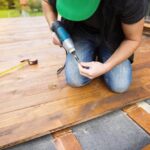Investing in a new home is one of the most exciting – and expensive – things you’ll do in your lifetime. Before you sign on the dotted line, it’s important to visit your future forever home at least once or twice, so you can get a proper feel for living there, and start planning for everything you need!
1. Explore the local area
The very first thing to consider when you’re moving home is the location. If you’re moving into a sought after area, you might need to compromise on a few things, but they shouldn’t be game-changers. Visiting your prospective houses at rush hour, when the road is more likely to be busy, will give you a good idea of how loud your future home might be, as well as whether you can park easily outside your home, and even how long your potential commute could be.
2. Consider the flooring
Decent flooring is one of the most attractive prospects for potential homeowners. As well as making each room seem lighter, brighter and more spacious, wooden flooring is incredibly durable. Keeping an eye out for hardwood flooring is a great way to spot whether you’re getting more for your money. Rather than carpets that quickly succumb to wear and tear, hardwood floorboards can last for decades when they’re looked after properly, and so are a great investment piece.
If the floorboards in your potential new home are looking a little tired, Quicksand Flooring is there to help with expert sanding, sealing and restoration services.

3. Take a look at the garden
While gardens are becoming more of a hot prospect than ever before thanks to national lockdowns, they can be tricky to look after if you’re not naturally green fingered. Taking into account how overgrown the garden of your prospective house is, whether there are any signs of uncontrollable weeds and if there’s any room for garden furniture will give you a much more clear idea of how much work needs to be done.
4. Don’t forget your signal strength
It’s an easy thing to forget about, but when you’re house hunting, it’s a good idea to check whether your phone gets any signal. There’s nothing more annoying than your phone cutting out mid-conversation. Especially if you’re looking to settle down in your next home in a rural area, checking out your phone signal and broadband strength will save you a lot of hassle and admin further down the line.
5. Think about storage space
No matter how beautiful a potential home is, if there’s no room for storage, things probably won’t work out. Looking for signs of clutter or excessive items piled up in attics or basements is a good sign that the current owners are finding storage space a little tight. You don’t want your freshly decorated rooms taken up by clutter, clothes or kids toys that don’t have a home.

6. Check for common expensive issues
Rotten windows, low water pressure and sloping floors are just some of the issues that see new homeowners’ costs quickly piling up. If you spot anything that looks a little suspicious while you’re house hunting, it’s worth raising it with the current owners, as they’ll often be able to compensate for the damage before they sell.
7. Visualise the floorplan
Is the bathroom a flight of stairs away from the main bedrooms, or the kitchen tucked away in a poky corner? Especially in old houses, unexpected floor plans can make all the difference to the enjoyment of your daily life. If you notice something that doesn’t feel quite right while you’re looking around a new house, it’ll probably come to get on your nerves, even more, when you’re actually living there. Unless you have the hefty budget needed to get your rooms just the way you want them, these houses are best to cross off the house hunting list altogether.
8. Look into lighting
Last but not least, visiting your potential home on a sunny day will give you a much better idea of how much natural light each room gets. Whether you’re a fan of big open windows or cosier, smaller rooms, houses that let the sunlight in will be warmer and brighter all year round. As well as adding to the aesthetic appeal of your home, this will help you save money on heating and lighting costs in the long run too.






